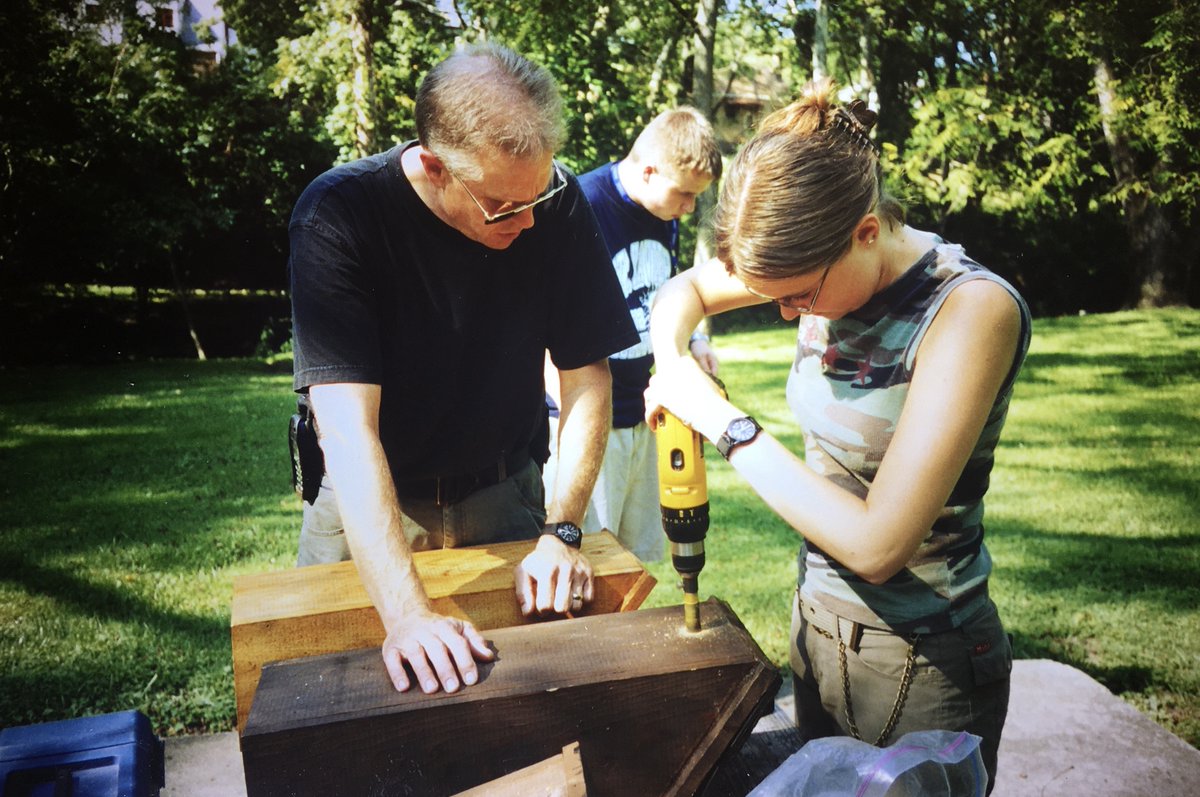Before we take flight with loads of bat info, I’d like to introduce myself & share a little about what it’s like getting to work with bats all around the world! Short answer: it’s AWESOME!
Check out a video from @CBSUnstoppable for some of what I do as a bat conservationist!
Check out a video from @CBSUnstoppable for some of what I do as a bat conservationist!
I get asked A LOT how I got started in #BatConservation. My journey began as a kid, when I relished watching for #bats during night hikes with my @girlscouts troop. Then in 6th grade I built and put up bat houses for my #SilverAward project. It’s never too early to get started!
Speaking of #BatHouses, check out these links for info on what makes a good bat house, tips for installation, and how to buy or build your own. (More bat house info to come later this week!):
https://www.batcon.org/about-bats/bat-houses/
https://batmanagement.com/collections/homeowner-sized-bat-houses
https://www.habitatforbats.org/bat-house-faq/
@xsuzi00
https://www.batcon.org/about-bats/bat-houses/
https://batmanagement.com/collections/homeowner-sized-bat-houses
https://www.habitatforbats.org/bat-house-faq/
@xsuzi00
After my first bat experience in 6th grade, I studied Zoology @OhioWesleyan & worked as a field assistant studying pest control services of #bats in Texas pecan orchards. Bats eat pecan pests, protecting the crops & saving farmers money!
@TexasFarmBureau
@TexasFarmBureau
[Tweet by @BatsForLife] I did my Honors Thesis on species’ preferences for #BatHouse design. I tested two types of bat houses in Texas: standard 4-chamber nursery houses and rocket boxes (both built from plans provided in @BatConIntl's Bat House Builder’s Handbook).
[Tweet by @BatsForLife] I used thermal imaging cameras to monitor the bats' investigatory behavior at the houses & conduct evening emergence counts. In this thermal video, you can see their morning swarming around the houses when they socialize before re-entering for the day.
[Tweet by @BatsForLife] In this thermal video, you can see the bats' "touch and go" behavior as they check out the rocket box #BatHouse. Excitingly for me, they then climb inside the open bottom and spend their days inside sleeping, socializing, and grooming!
[Tweet by @BatsForLife] I also set up infrared cameras near the bat houses to watch them come out and count how many were roosting in each house. Each of these houses can hold several hundred bats that eat pest insects like mosquitoes and agricultural pests.
[Tweet by @BatsForLife] Evening bats loved the rocket boxes, perhaps because they resemble their natural roosts (tree cavities). Mexican free-tailed bats liked the standard houses at first, but eventually also moved into the rocket boxes. Look at all of them coming out!
[Tweet by @BatsForLife] After college, I spent a year in South Australia on a @FulbrightPrgrm Fellowship studying the critically endangered Southern bent-wing bat in Naracoorte Caves National Park. Below are some photos inside Bat Cave.
[Tweet by @BatsForLife] I used thermal cameras & an automated tracking system to do population counts at a maternity cave. While this may look like a lot of bats, the species has seen drastic declines over several decades. How many bats do you think live in this cave? Post below!
[Tweet by @BatsForLife] In 2014, I started my #PhD at the @universityofga’s @UGAICON program. I spent 6 years studying endangered pollinating bats in northeast Mexico that feed on agave nectar (which, by the way, we use to make #TEQUILA!).
[Tweet by @BatsForLife] Endangered Mexican long-nosed bats rely on the nectar of agave plants to fuel their 700+ mile annual migration. Agaves, in turn, rely on these bats for pollination. AND people throughout Mexico harvest agaves for many important cultural and economic uses.
[Tweet by @BatsForLife] The bats are losing their foraging habitat due to threats like land conversion, so my interdisciplinary PhD used natural & social sciences to understand how we can work w/ Mexican communities to protect agaves for both bats & people
http://icon.uga.edu/wp-content/uploads/2019/07/icon-research-brief-lear.pdf
http://icon.uga.edu/wp-content/uploads/2019/07/icon-research-brief-lear.pdf

 Read on Twitter
Read on Twitter

![[Tweet by @BatsForLife] I did my Honors Thesis on species’ preferences for #BatHouse design. I tested two types of bat houses in Texas: standard 4-chamber nursery houses and rocket boxes (both built from plans provided in @BatConIntl's Bat House Builder’s Handbook). [Tweet by @BatsForLife] I did my Honors Thesis on species’ preferences for #BatHouse design. I tested two types of bat houses in Texas: standard 4-chamber nursery houses and rocket boxes (both built from plans provided in @BatConIntl's Bat House Builder’s Handbook).](https://pbs.twimg.com/media/EqWzXLOUYAAd5CX.jpg)
![[Tweet by @BatsForLife] I did my Honors Thesis on species’ preferences for #BatHouse design. I tested two types of bat houses in Texas: standard 4-chamber nursery houses and rocket boxes (both built from plans provided in @BatConIntl's Bat House Builder’s Handbook). [Tweet by @BatsForLife] I did my Honors Thesis on species’ preferences for #BatHouse design. I tested two types of bat houses in Texas: standard 4-chamber nursery houses and rocket boxes (both built from plans provided in @BatConIntl's Bat House Builder’s Handbook).](https://pbs.twimg.com/media/EqWzZrKVgAIazOS.jpg)
![[Tweet by @BatsForLife] I did my Honors Thesis on species’ preferences for #BatHouse design. I tested two types of bat houses in Texas: standard 4-chamber nursery houses and rocket boxes (both built from plans provided in @BatConIntl's Bat House Builder’s Handbook). [Tweet by @BatsForLife] I did my Honors Thesis on species’ preferences for #BatHouse design. I tested two types of bat houses in Texas: standard 4-chamber nursery houses and rocket boxes (both built from plans provided in @BatConIntl's Bat House Builder’s Handbook).](https://pbs.twimg.com/media/EqWzc3XUcAAWMqx.jpg)
![[Tweet by @BatsForLife] I did my Honors Thesis on species’ preferences for #BatHouse design. I tested two types of bat houses in Texas: standard 4-chamber nursery houses and rocket boxes (both built from plans provided in @BatConIntl's Bat House Builder’s Handbook). [Tweet by @BatsForLife] I did my Honors Thesis on species’ preferences for #BatHouse design. I tested two types of bat houses in Texas: standard 4-chamber nursery houses and rocket boxes (both built from plans provided in @BatConIntl's Bat House Builder’s Handbook).](https://pbs.twimg.com/media/EqWzgGNVQAACU4i.jpg)
![[Tweet by @BatsForLife] I also set up infrared cameras near the bat houses to watch them come out and count how many were roosting in each house. Each of these houses can hold several hundred bats that eat pest insects like mosquitoes and agricultural pests. [Tweet by @BatsForLife] I also set up infrared cameras near the bat houses to watch them come out and count how many were roosting in each house. Each of these houses can hold several hundred bats that eat pest insects like mosquitoes and agricultural pests.](https://pbs.twimg.com/media/EqW4LBsU8AE2VM5.jpg)
![[Tweet by @BatsForLife] I also set up infrared cameras near the bat houses to watch them come out and count how many were roosting in each house. Each of these houses can hold several hundred bats that eat pest insects like mosquitoes and agricultural pests. [Tweet by @BatsForLife] I also set up infrared cameras near the bat houses to watch them come out and count how many were roosting in each house. Each of these houses can hold several hundred bats that eat pest insects like mosquitoes and agricultural pests.](https://pbs.twimg.com/media/EqW3f9KVQAAD0NM.jpg)
![[Tweet by @BatsForLife] I also set up infrared cameras near the bat houses to watch them come out and count how many were roosting in each house. Each of these houses can hold several hundred bats that eat pest insects like mosquitoes and agricultural pests. [Tweet by @BatsForLife] I also set up infrared cameras near the bat houses to watch them come out and count how many were roosting in each house. Each of these houses can hold several hundred bats that eat pest insects like mosquitoes and agricultural pests.](https://pbs.twimg.com/media/EqW3clGVoAAtmyj.jpg)
![[Tweet by @BatsForLife] After college, I spent a year in South Australia on a @FulbrightPrgrm Fellowship studying the critically endangered Southern bent-wing bat in Naracoorte Caves National Park. Below are some photos inside Bat Cave. [Tweet by @BatsForLife] After college, I spent a year in South Australia on a @FulbrightPrgrm Fellowship studying the critically endangered Southern bent-wing bat in Naracoorte Caves National Park. Below are some photos inside Bat Cave.](https://pbs.twimg.com/media/EqXFXR5VEAEdAS0.jpg)
![[Tweet by @BatsForLife] After college, I spent a year in South Australia on a @FulbrightPrgrm Fellowship studying the critically endangered Southern bent-wing bat in Naracoorte Caves National Park. Below are some photos inside Bat Cave. [Tweet by @BatsForLife] After college, I spent a year in South Australia on a @FulbrightPrgrm Fellowship studying the critically endangered Southern bent-wing bat in Naracoorte Caves National Park. Below are some photos inside Bat Cave.](https://pbs.twimg.com/media/EqXDsYEUUAAzJek.jpg)
![[Tweet by @BatsForLife] After college, I spent a year in South Australia on a @FulbrightPrgrm Fellowship studying the critically endangered Southern bent-wing bat in Naracoorte Caves National Park. Below are some photos inside Bat Cave. [Tweet by @BatsForLife] After college, I spent a year in South Australia on a @FulbrightPrgrm Fellowship studying the critically endangered Southern bent-wing bat in Naracoorte Caves National Park. Below are some photos inside Bat Cave.](https://pbs.twimg.com/media/EqXD5MNUcAAy2Ac.jpg)
![[Tweet by @BatsForLife] In 2014, I started my #PhD at the @universityofga’s @UGAICON program. I spent 6 years studying endangered pollinating bats in northeast Mexico that feed on agave nectar (which, by the way, we use to make #TEQUILA!). [Tweet by @BatsForLife] In 2014, I started my #PhD at the @universityofga’s @UGAICON program. I spent 6 years studying endangered pollinating bats in northeast Mexico that feed on agave nectar (which, by the way, we use to make #TEQUILA!).](https://pbs.twimg.com/media/EqXQeKqUUAAiw_Z.jpg)
![[Tweet by @BatsForLife] Endangered Mexican long-nosed bats rely on the nectar of agave plants to fuel their 700+ mile annual migration. Agaves, in turn, rely on these bats for pollination. AND people throughout Mexico harvest agaves for many important cultural and economic uses. [Tweet by @BatsForLife] Endangered Mexican long-nosed bats rely on the nectar of agave plants to fuel their 700+ mile annual migration. Agaves, in turn, rely on these bats for pollination. AND people throughout Mexico harvest agaves for many important cultural and economic uses.](https://pbs.twimg.com/media/EqXSaEKVQAAE-mI.jpg)
![[Tweet by @BatsForLife] Endangered Mexican long-nosed bats rely on the nectar of agave plants to fuel their 700+ mile annual migration. Agaves, in turn, rely on these bats for pollination. AND people throughout Mexico harvest agaves for many important cultural and economic uses. [Tweet by @BatsForLife] Endangered Mexican long-nosed bats rely on the nectar of agave plants to fuel their 700+ mile annual migration. Agaves, in turn, rely on these bats for pollination. AND people throughout Mexico harvest agaves for many important cultural and economic uses.](https://pbs.twimg.com/media/EqXR5ifUUAEIda1.jpg)
![[Tweet by @BatsForLife] Endangered Mexican long-nosed bats rely on the nectar of agave plants to fuel their 700+ mile annual migration. Agaves, in turn, rely on these bats for pollination. AND people throughout Mexico harvest agaves for many important cultural and economic uses. [Tweet by @BatsForLife] Endangered Mexican long-nosed bats rely on the nectar of agave plants to fuel their 700+ mile annual migration. Agaves, in turn, rely on these bats for pollination. AND people throughout Mexico harvest agaves for many important cultural and economic uses.](https://pbs.twimg.com/media/EqXSceaUYAMHfoo.jpg)


